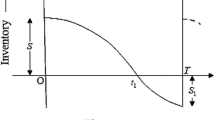Abstract
In this study, we have discussed the development of an inventory model when the deterioration rate of the item follows Weibull two parameter distributions under the effect of selling price and time dependent demand, since, not only the selling price, but also the time is a crucial factor to enhance the demand in the market as well as affecting the overall finance. In the present model, shortages are approved and also partially backlogged. Optimum inventory level, the optimal length of a cycle and the expressions for profit function under various cost considerations are obtained using differential equations. These are illustrated graphically with the help of numerical examples. The sensitivity analysis of the standards of the parameters has been performed to study the effect on inventory optimizations.



Similar content being viewed by others
References
Berrotoni J N 1962 Practical applications of Weibull distribution. ASQC Tech. Conf. Trans. 303–323
Papachristos S and Skouri K 2003 An inventory model with deteriorating items, quantity discount, pricing and timedependent partial backlogging. Int. J. Prod. Econ. 83: 247–256
Wee H M 1999 Deteriorating inventory model with quantity discount, pricing and partial backordering. Int. J. Prod. Econ. 59: 511–518
Deng P S 2005 Improved inventory models with ramp type demand and Weibull deterioration. Inform. Manag. Sci.16: 79–86
Wei P, Hua G Yu L, Zhang J, Xie G and Wang S 2009 Determining optimal selling price, order size and the number of price changes with Weibull distribution deterioration. J. Comput. 4: 1294–1300
Skouri K, Konstantaras I, Papachristos S and Ganas I 2009 Inventory models with ramp type demand rate, partial backlogging and Weibull deterioration rate. Eur. J. Oper. Res. 192: 79–92
Tripathy P K and Pradhan S 2011 An integrated partial backlogging inventory model having Weibull demand and variable deterioration rate with the effect of trade credit. Int. J. Sci. Eng. Res. 2: 1–5
Valliathal M and Uthayakumar R 2011 A new study of an EOQ model for deteriorating items with shortages under inflation and time discounting. Iranian J. Oper. Res. 2: 48–62
Nandgopal R and Thirumalaisamy V 2012 An inventory model for items with two parameter Weibull distribution deterioration and backlogging. Am. J. Oper. Res. 2: 247–252
Pradhan L M and Tripathy C K 2013 An EOQ model for three parameter Weibull deteriorating item with partial backlogging. Sci. J. Logist. 9: 35–42
Tripathy C K and Pradhan L M 2010 An EOQ model for Weibull deteriorating items with power demand and partial backlogging. Int. J. Contemp. Math. Sci. 5: 1895–1904
Bhaskar B and Rajendra M K 2014 An economic order quantity model for Weibull deteriorating items with stock dependent consumption rate and shortages under inflation. Int. J. Comp. Tech. 1: 196–204
Acharya Milu and Debata Samrutirekha 2007 An inventory model for deteriorating items with time dependent demand under partial backlogging. Int. J. Res. Adent Tech. 2: 1–5
Zhao Q Z and Zhao P X 2007 Improved EOQ model for items with Weibull distribution deterioration. International Conference on Transportation Engineering, pp 2889–2894
Jolai F, Tavakkoli-Moghaddam R, Rabbani M and Sadoughian M R 2006 An economic production lot size model with deteriorating items, stock-dependent demand, inflation, and partial backlogging. Appl. Math. Comput. 181: 380–389
Wu K S 2001 An EOQ inventory model for items with Weibull distribution deterioration, ramp type demand rate and partial backlogging. Prod. Planning Control 12: 787–793
Garg S, Patra K and Pal SK 2014 Particle swarm optimization of a neural network model in a machining process. Sadhana 39(3): 533–48
Hong X, Chunyuan W, Xu L and Diabat A 2016 Multiple-vendor, multiple-retailer based vendor-managed inventory. Ann. Oper. Res. 238: 277–297
Chang C T, Teng J T and Goyal S K 2010 Optimal replenishment policies for non-instantaneous deteriorating items with stock-dependent demand. Int. J. Prod. Econ. 123: 62–68
Soto-Silva W E, Nadal-Roig E, González-Araya M C and Pla-Aragones L M 2016 Operational research models applied to the fresh fruit supply chain. Eur. J. Oper. Res. 251: 345–355
Mishra U 2015 A waiting time deterministic inventory model for perishable items in stock and time dependent demand. Int. J. Syst. Assur. Eng. Manag. 1–11. doi:10.1007/s13198-015-0404-0
Acknowledgement
One of the authors Mr. Shiv Kumar is grateful to the Indian School of Mines, Dhanbad authorities for financial support in the form of a Research Fellowship and facilitating the best facility. The authors declare that they have no conflict of interest.
Author information
Authors and Affiliations
Corresponding author
Rights and permissions
About this article
Cite this article
KUMAR, S., SINGH, A.K. & PATEL, M.K. Optimization of Weibull deteriorating items inventory model under the effect of price and time dependent demand with partial backlogging. Sādhanā 41, 977–984 (2016). https://doi.org/10.1007/s12046-016-0533-4
Received:
Revised:
Accepted:
Published:
Issue Date:
DOI: https://doi.org/10.1007/s12046-016-0533-4




